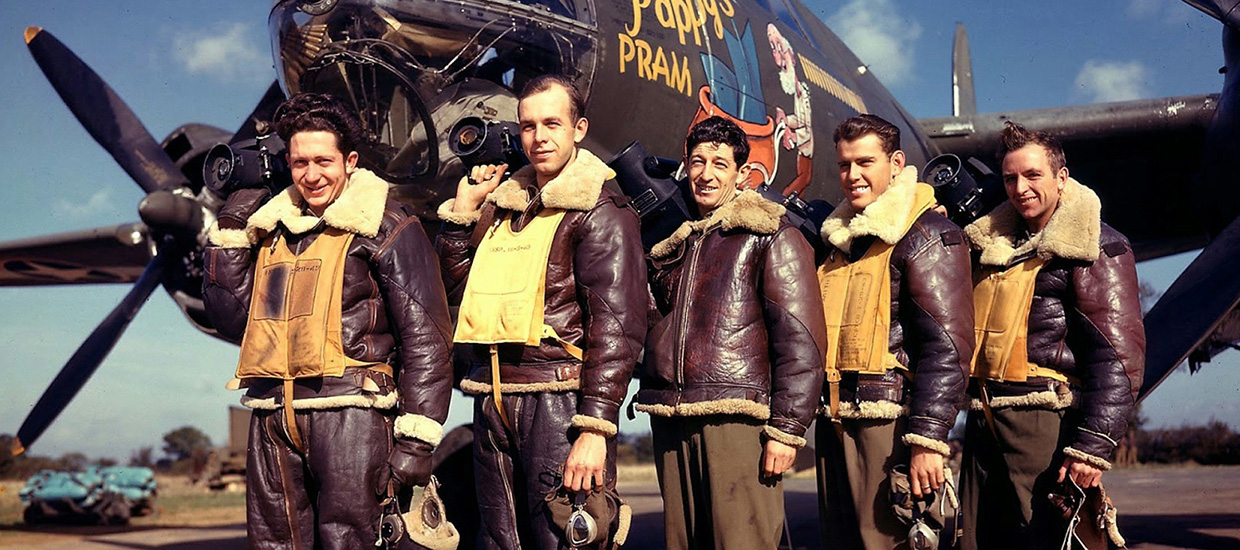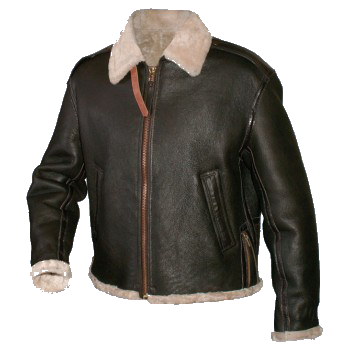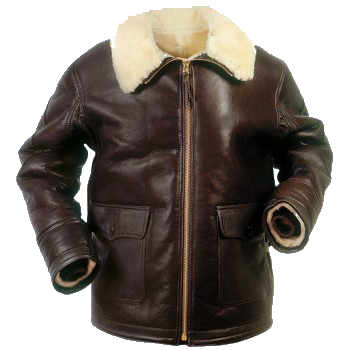Product added to cart
- Home
- The Treasure Blog @flightjacket.com
- Sheepskin Bomber Jackets Historical View


Since the earliest days of flight one inherent problem for the aviator was how to stay warm in the open-air cockpit. Initially, turn of the century pilots did not experience the extreme cold temperatures of high-altitude flight, as they were limited by the technology and the inability of their aircrafts to go beyond 10,000ft. into the sky. However, on December 26 th , 1910, a well-known pilot of the day by the name of Archibald Hoxsey changed all of that when he flew his Wright Model B aircraft to what was then the astonishing record height of 11,474 feet. 

The wearing of leather with sheepskin linings served multiple purposes for the early aviators, by utilizing leather to block the flow of cold air and sheepskin to retain body warmth. With the onset of World War I there were new demands for warmer clothing, as several of the aircrafts being flown could reach altitudes of 20,000 feet or greater. At that height temperatures ranged from -12 to -21 degrees Fahrenheit. As a result, entire sheepskin and leather suits were manufactured by companies under contract with the French and US Governments to produce Sheepskin lined boots, jackets, pants, mittens, along with flight suits and helmets. By the 1920’s this became the standard wear of the aviators of the day.
The utilization of sheepskin became so commonplace, that it was in continuous use throughout the 1920’s and 1930’s by both civilian and military flyers alike. In 1934 the US. Army Air Corp took delivery of a new high altitude flight suit of which the, “Jacket, Flying, Winter, Type B-3 “was born. The B-3 jacket was issued to all pilots and flight crews of bombers along with Sheepskin lined pants known as “Trousers, Flying, Winter, Type A-3”. These, along with Sheep lined mittens, leather helmets, and boots became the standard flight uniform throughout the remainder of the 1930’s and 1940’s until the end of World War II in 1945. A number of other sheepskin jackets were contracted for during this period by the US Army Air Force to include the D-1 mechanics jacket, and the B-6 light weight sheepskin flight jacket.

The Axis powers of World War II also made good use of Sheepskin in their respective flight jackets and flight clothing. Photographs and documentary videos of Japanese pilots attacking Pearl Harbor during the opening strike of World War II, wearing sheep lined flight uniforms with fur lined leather flight helmets, can be found everywhere on the web. 
Our British allies were able to create an image that we still remember today, of young airmen wearing one of the most famous sheepskin jackets of World War II. Probably the most iconic photographs of airmen wearing sheepskin jackets can be found in old photographs of RAF pilots from the famous 1940 Battle of Britain and their counterparts of the RAF Bomber Command. The Irvin and Warings sheepskin jackets of that period were synonymous with the young daring adventurous pilots and air crews of those days. If you can find an original RAF Irvin jacket in good condition today, rest assured that it will come with a hefty price tag.

World War II ended on September 2, 1945 and with it ended the need and use of sheepskin in most flight wear. The civilian Army & Navy surplus market was flooded with excess sheepskin flight jackets that could be purchased for pennies on the dollar. In the early 1950’s sheepskin jackets like the B-3, B-6, and the D-1 could be purchased for around $10.00 to $18.00 depending on which jacket you wanted to buy. Some young men who were air crew members who made it home with their jackets wore them in civilian life with distinction as a badge of honor, while others simply left them balled up in their trunks or overseas bags, wanting to forget the carnage of war and anything associated with it.
The jackets were purchased by numbers of young men, working construction jobs outside in the cold winter weather, or young thrill seekers wearing them while riding around on their motorcycles or just by guys who thought the sheepskin jacket made them look cool, like the Hollywood types who wore them such as Steve McQueen, James Dean and a few others. In time the coolness factor wore off and sheepskin jackets slowly disappeared. Periodically the fashion industry would reach back and pull the B-3 sheepskin jacket out of the past and give it some modern-day trim and other features and it would sell for a while, but eventually it would fade back into history only to be pulled out again in another ten years or so. Many of the original examples of the World War II jackets are gone now. They just fell apart due to the tanning methods and coatings that were applied during the manufacture of the jackets. If you are lucky enough to find an original in good condition without rips, tears, or dry rot it will have a fairly expensive price tag. Original sheepskin jackets with World War II artwork will be even more costly, possibly in the four or five figure price ranges. Reproduction sheepskin jackets are much more accessible and less costly. You also have the added benefit of knowing that you are not helping an original World War II artifact meet its demise.
If you are in the market for a real sheepskin jacket, buyers beware. Sheepskin is a commodity and therefore fetches a prime price due to the cost of the real sheepskin and the labor expertise that's require to assemble such jackets. In an effort to make it affordable, some companies will use a leather shell with a man-made fabric fleece that imitates the original. Although price can be substantially reduced, it is a far from the authentic shearling jacket in warmth and quality.
And just for the record, I’m the happy owner a number of sheepskin jackets, originals and reproductions, and I wear them all………..Uh ..the reproductions of course.
- Pictures 1-5 taken at The United States Air Force National Museum, Dayton Ohio
Related Products
- B-6 Sheepskin Jacket$1,045.00 $1,595.00
- M-444 Sheepskin Jacket$1,395.00 $2,195.00
- B-2 Sheepskin Cap$249.00 $375.00
- A-5 Sheepskin Trousers$1,295.00 $1,695.00
- D-1 Sheepskin Jacket$995.00 $1,495.00
0 Comment(s)
Recent Posts
July 04, 2021
Top Gun - The Jacket for mavericks June 29, 2021
Sheepskin Bomber Jackets Historical ViewJune 21, 2021
The Art of making a military style PatchesJune 15, 2021
Can Tigers fly? The Flying Tigers StoryJune 01, 2021
Bomber Jackets, Classic vs ModernTags
wwii bomber jackets bomber jacket noseart pinup girls flight jacket leather flight jacket leather bomber jacket a2 jacket g1 jacket namy leather jacket military fit authentic true to original flying tigers avg american volunteer group hell angels adam and eve panda bears kunming china cbi flying tigers jacket embossed leather patch embossed patch embossing navy patch military patches sheepskin jacket shearling jacket sheepskin bomber jacket b3 jacket raf jacket top gun topgun top gun jacket maverick lt. p. mitchell pete mitchell tom cruz













